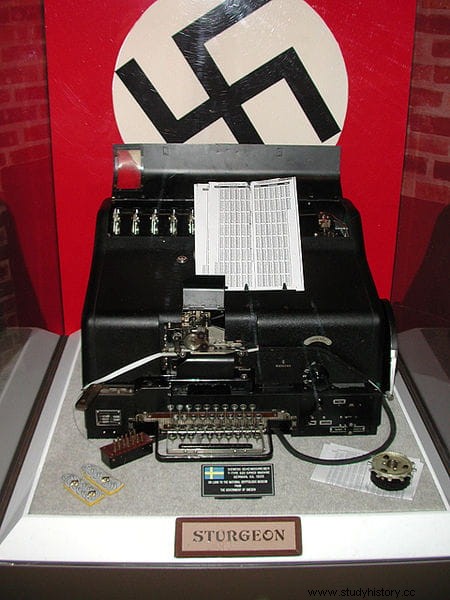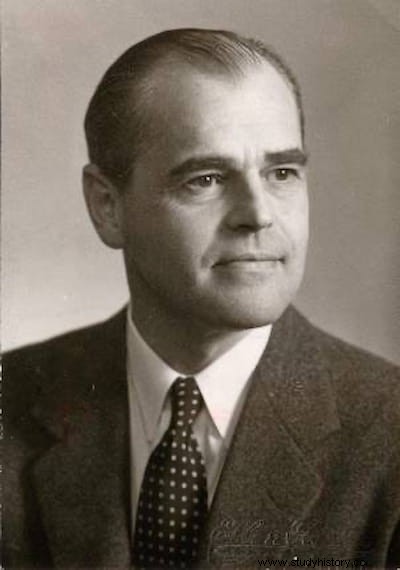Encrypting messages is a resource that dates back to ancient times and has always been used in times of war, although probably the most famous episode on this subject is the cracking of the code used by the Germans in their Enigma machine during World War II:less than two years it took the Allies to unravel it, thanks to the work of Polish technicians and the mathematician Alan Turing, among other factors. The time taken seems surprisingly short, but in 1940 another mathematician, in this case a Swedish one, only took a couple of weeks to do the same with the encryption system of a device more complex than the Enigma , and above using only pencil and paper. His name was Arne Beurling.
That other machine was the Siemens &Halske T52, also known as the SFM (stands for Schlüsselfernschreibmaschine , Key Teletype) or Geheimschreiber (Secret Teleprinter), although its most famous nickname is the one given to it by the allies:Sturgeon . It was also used by the Germans, but if the Enigma it was for the mobile troops and the SZ 42 Lorenz constituted a heavy system of the Wehrmacht, the users of the T52 they were the commanders of the Luftwaffe and the Kriegsmarine (for the latter it had been originally designed).
The bletchleys (British cryptanalysts, named after their headquarters in Bletchley Park) had a way of referring to each German cipher machine, being Fish the name for all in general because, in an intercepted message in the NoMo system, sent via Enigma, discovered that the Germans called Sägefisch (Sierrafish) to one of their wireless teleprinter transmission systems. Thus, the SZ Lorenz became Tunny (Tuna) and the T52 -of which Siemens made several versions-, Sturgeon (Sturgeon). In the last months of the war, the Germans launched another, the T43, which the bletchleys they would call Trasher .

Unlike Enigma, which required reading the encryption result, annotating it, and transmitting it in morse, the T52 performed those steps automatically:the operator only had to type the text, which the machine then encrypted and sent as a teletype; once this was received, the machine itself deciphered it. The great advantage of all this was twofold:on the one hand, speed; on the other, that the user did not need to know the code (in addition, the T52 d and T52e removed the defect of the previous ones, which could save the keys, which led some operators to repeat them, with the consequent danger of facilitating their decoding by the enemy).
The operating system was also much more complex than that of Enigma and Lorenz, based on a GPAN (pseudo-random number generator), an algorithm that produces a sequence of numbers that is a good approximation to a random set of figures but not totally random. , since it is determined by a relatively small set of initial values, the so-called state. This was combined with the use of ten reels instead of the usual five in other machines, which also were not staggered linearly, generating a quintillion combinations.
T52a was born and used long before the war, between 1932 and 1934, but T52b was developed between 1934 and 1942, with which it participated in the war, although they only differed in the suppression of electrical noise. However, that second year, the mathematician and cryptologist Heincrich Döring, of the OKH (Oberkommando des Herees ), conducted a study showing that if you accidentally sent a pair of ciphertexts of a few hundred letters with the same key, it would be easy to "break" them ("break" is the term that decoding is called in jargon, while to refer to a weakness such as the one denounced by Döring, the word "depth" is used). And, indeed, the bletchley they had managed to find a «depth « on the T52b and unravel the codes.

That led to the Luftwaffe required speeding up the entry into service of an improvement that had been worked on since 1941, the T52c, which, not reaching the expected level, gave way to another generation, the T52d. Döring showed that this was not totally safe either, so in 1944 the most advanced and safest T52e would arrive. Of course, by then the war was virtually lost, hence another improved version, the T52f, no longer had time to be released in the war context. Besides, there was the fact that a Swedish professor had unraveled his secret. Let's see.
You have to go back to Gothenburg in 1905, the place and year in which Arne Carl-August Beurling was born into a noble family. His first bachelor's degree, from Uppsala University in 1924, is somewhat surprising because he got it in Arts; the second, two years later, is no less so for being in Philosophy. However, the title that interests us here is the doctorate in Mathematics, obtained in 1933, which gave him the definitive place to teach that subject at the university four years later. His meteoric career was to surpass even that tragedy that befell the world in 1939, World War II.

He had the advantage that, following his customary historical political line since the end of the Napoleonic wars, Sweden opted for neutrality and managed to maintain it throughout the conflict, even if he had to make concessions to one side or the other; first, to the Axis, fearing that Great Britain would not have the capacity to protect the country if the Germans tried to occupy it; then, especially from the last months of 1943, when it became clear that the balance was tipping towards the Allies. However, before there were sporadic attempts to act underground, both officially and individually; one of those that could be framed in the second type was the one starring Arne Beurling.
In April 1940, Germany unleashed Operation Weserübung, that is, the invasion of Denmark and Norway, despite the fact that they were also neutral countries. The excuse used by the Teutonic government was to protect them from an identical action by England and France, which had blockaded the port of Narvik because mining shipments were shipped from there (mainly Swedish iron) that supplied the Hitler regime. Many Swedes then feared that they would be next. Some reacted by supporting collaboration with the Nazis; others, on the contrary.
Once Norway was controlled, something they achieved in just two months and with few casualties using as casus belli the boarding of the freighter Altmark by forces of the RAF and the Royal Navy despite being in Scandinavian waters, they established a line of communication with Germany through Sweden. Evidently, the transmissions were encrypted using the T52, which at first seemed like a guarantee of security, given that the system was complex, as we explained before. Nobody expected a simple teacher to "break" it using only his knowledge of mathematics, a pencil and a piece of paper. And even less alone.
Beurling, who had trained as a cryptographer during his military service, like many mathematicians, went to work on intercepted messages on the telegraph lines that crisscrossed his country; he provided them Crypto Detail IV , the cryptographic department of the National General Staff, which in turn obtained them from the operator Ericsson, which had had to give in to the Wehrmacht's demand to be able to use its network. He would never reveal how he did it, but amazingly, it took no more than a couple of weeks in the summer of 1940 to crack two of them, allowing the company to make replicas of the T52 machines. Duly distributed throughout the national territory, they served to find out about the communications between Berlin and the German embassies in Oslo and Stockholm for three years, as well as between Germany and her troops in Finland.

The Swedes, who took the opportunity to found the FRA (Försvarets Radioanstalt , National Defense Radio Establishment), even learned of the imminent start of Operation Barbarossa (the invasion of the Soviet Union), but their warning to Moscow fell on deaf ears because they did not want to reveal how they had obtained the information and, therefore, , was not considered credible by the Soviet government, which was believed safe by the signing of the Ribbentrop-Molotov Pact and was caught by surprise; we saw it here in another article.
Up to half a million messages were intercepted, of which two-thirds were decrypted. Such a loss of data ended up alerting the Germans, who understood that something was happening, hence the improvements made to the T52. As we said, the b and the c they were mediocre and the Scandinavians were able to get around them; not so the d , which put an end to interceptions in mid-1943. But by then two things had happened that completely changed the picture.

On the one hand, the Poles of the Biuro Szyfrów (cryptographic agency) had obtained in 1939 a non-military Enigma, from which they investigated and finally sent everything to Bentchley Park, where a team of mathematicians and cryptographers led by Alan Turing unraveled the operation. of the machine (to which would be added the capture in 1941 of a German submarine, the U-110, with its Enigma and a code book). On the other hand, in August 1941 the English chemist and mathematician William Thomas Tutte, a member of thebletchleys , he managed to "break" the encoding of Tunny (the Lorenz machine) with an ease analogous to that of Arne Beurling.
Finally, and albeit with difficulties, the bentchleys also "broke" Sturgeon, partly thanks to the Luftwaffe it transmitted its messages in less complex codes, often recklessly reusing them, and sometimes using more insecure Enigma machines, all of which made it easier for the enemy to crack them. We have already seen in another article that the Japanese ambassador in Berlin had also committed a similar imprudence. The British thus put themselves at the level of the Swedes, who, as it turns out, had not been informed of Arne's success due to his neutrality.
This one, who after the war would be a professor at Harvard and Princeton (at the IAS Institute for Advanced Study , where he worked with Einstein), as well as doctoral tutor for other scientific geniuses such as Lennart Carlesson and Carl-Gustav Esseen, would make transcendental contributions to the field of mathematics, such as the factorization theorem in internal and external functions that bears his name.

He passed away in the US in 1986, but before that, in 1967, he had earned a brilliant praise from David Kahn, author of the famous book The codebreakers :
